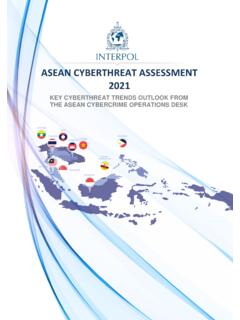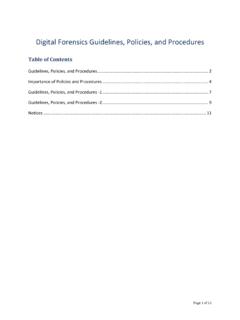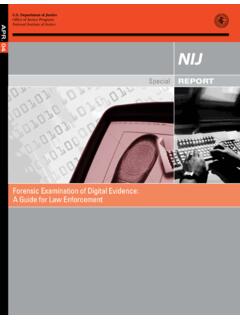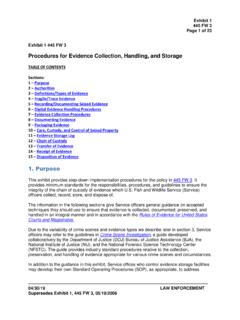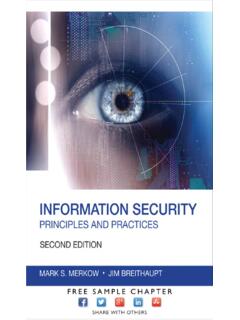Transcription of GUIDELINES FOR DIGITAL FORENSICS FIRST RESPONDERS
1 GUIDELINES FOR DIGITAL FORENSICS . FIRST RESPONDERS . Best practices for search and seizure of electronic and DIGITAL evidence March 2021. 1010101$10101010101010101 01010101010101 01010101010101 01010101010101$. 01010101010101$01010101010101 01010101010101 01010101010101$01010101010. 2. 10101$01010101010101 01010101010101 01010101010101$01010101010101 01010. Disclaimer These GUIDELINES for DIGITAL FORENSICS FIRST RESPONDERS (the GUIDELINES ) have been prepared as technical GUIDELINES to provide information and advice on DIGITAL forensic approaches that may be adopted when seizing and analysing different kinds of devices. These GUIDELINES are solely for the use of law enforcement professionals having the necessary legal basis or authorisation to perform the actions described herein. The legal, procedural and customary frameworks in respect of search, seizure, chain of custody, analysis, reporting, submission in criminal/prosecution/judicial process, evidentiary evaluation, admissibility and probative value, etc.
2 , differ widely by jurisdiction. These GUIDELINES do not provide any recommendations, advice or instructions in respect of requirements under such legal and procedural frameworks in any jurisdiction and any references seemingly suggesting as such should be read as being subject to domestic laws and procedures in this regard. Readers are advised to ensure, when taking any actions based on these GUIDELINES , to verify and be satisfied that such actions are in compliance with appropriate legal and procedural requirements or standards in their jurisdictions. These GUIDELINES are not mandatory in nature and have no enforceability. INTERPOL shall not be liable for any actions taken by any parties based on these GUIDELINES which are contrary to or inconsistent with or not in compliance with any relevant legal, regulatory, administrative, procedural, evidentiary, customary, or other requirements, exhibit extraction processes, chain of custody records to be maintained, etc.
3 These GUIDELINES also include mentions of open source, proprietary and publicly available tools and services (collectively, the Tools and each, a Tool ) that offer various functionalities. They may be viewed, downloaded and/or used at the discretion of the user. In relation to these, please note the following: INTERPOL has not developed or verified the Tools, does not endorse them, has no association with their providers, and does not license or provide any support for the use of such Tools. INTERPOL provides no warranties (express or implied) in relation to the Tools or any of them, their utility for any purpose or effectiveness. Links to other websites from these GUIDELINES do not constitute an endorsement by INTERPOL, and are only provided as a convenience. It is the responsibility of the user to evaluate the content and usefulness of information obtained from other websites/ using these Tools.
4 INTERPOL does not control, monitor or guarantee the contents of the links or the Tools provided herein, or their data collection practices; it does not endorse any views expressed or products or services offered therein. $01010101010101 01010101010101 01010101010101$01010101010101 0101010101. 0101 01010101010101 01010101010101$01010101010101 01010101010101 010101. 3. 0101010101 01010101010101$01010101010101 01010101010101 01010101010101$. It may be necessary to create user accounts, pay subscription or one-time fees or upgradation fees in order to use some of these Tools. Registration or creation of user accounts, payment of fees or charges may require authorisation from your organisation and be subject to legal requirements in your jurisdiction (including for the creation of fake or assumed identities for this purpose). Please ensure that you have the requisite authorisations to use the Tools.
5 INTERPOL does not encourage or in any manner, authorise doing so, and will not be liable in respect of any actions you take to create accounts or registrations, pay any fees or subscriptions, or if you assume any identities or create fake credentials, in order to use any Tool. Each of these Tools may be subject to licenses, privacy policies and to the terms contained therein. Please review carefully any such terms, conditions or privacy policies that apply to the use of any Tool you wish to use. Information entered into any of the Tools may be saved on the servers of the company that provides the Tool, and the legality of this within your jurisdiction must be tested and verified by you. It is also the responsibility of the user to test the data collection practices and privacy policies of the Tools as against their national legal requirements. Any use of the Tools (or any of them) is at your own risk, and INTERPOL shall not be liable or responsible under any circumstances for any damage or loss incurred, caused or alleged to be caused due to your use of or reliance upon any of these Tools.
6 Any claims or actions in relation to any damage or loss incurred by a user should be directed to the providers of the Tool(s). and not INTERPOL. No data that is input in the use of any of these Tools will be transmitted to or be available to INTERPOL in any way. Should you choose to use any of the Tools for forensic , analytical or investigative purposes, you acknowledge that INTERPOL shall not receive any information in this regard, and at no point will be in the chain of custody of any evidence analyzed or generated using any such Tool. 1010101$10101010101010101 01010101010101 01010101010101 01010101010101$. 01010101010101$01010101010101 01010101010101 01010101010101$01010101010. 4. 10101$01010101010101 01010101010101 01010101010101$01010101010101 01010. Acknowledgements The GUIDELINES are based on the Electronic Evidence Guide of the Council of Europe, on the DIGITAL Evidence Collection Certificate Manual of the National Center of Excellence in Cybersecurity in Spain (INCIBE), and other best practice guides of law enforcement agencies concerning the seizure and treatment of electronic evidence.
7 The INTERPOL Innovation Centre DIGITAL FORENSICS Laboratory (IC. DFL) also received feedback from DIGITAL forensic experts from different parts of the world, to meet a consensus for some of the debated or troublesome aspects encountered by DIGITAL forensic FIRST RESPONDERS . We wish to mention and thank the following colleagues below, whose valuable input has helped to improve the agencies worldwide: BRAZIL: National Institute of Criminalistics Brazilian Federal Police;. SPAIN: Cybercrime Unit, General Commissary of Criminal Police (CGPJ) of Spanish National Police (CNP);. The Scientific Working Group on DIGITAL Evidence (SWGDE). INTERPOL would also like to express its sincere gratitude to the Norwegian Ministry of Foreign Affairs for their support and contribution in the creation of the GUIDELINES . The GUIDELINES will be referenced during an online training activity (Nov-Dec 2020), conducted in the framework of INTERPOL Project LEADER; a three-year capacity building initiative funded by the Norwegian Ministry of Foreign Affairs.
8 The project focuses on enhancing DIGITAL FORENSICS capacities of beneficiaries' in the South and Southeast Asia region. Through such endeavours, key stakeholders' of the project including DIGITAL forensic FIRST RESPONDERS and their law enforcement institutions will have the opportunity to strengthen their knowledge on the best practices articulated herein. Moreover, the GUIDELINES will also serve the purpose as an invaluable reference tool across all INTERPOL member countries ensuring that advice on the handling, collecting and preservation of DIGITAL evidence to support investigations, are available to those law enforcement officers involved in such procedures. $01010101010101 01010101010101 01010101010101$01010101010101 0101010101. 0101 01010101010101 01010101010101$01010101010101 01010101010101 010101. 5. 0101010101 01010101010101$01010101010101 01010101010101 01010101010101$. Foreword In pursuit of providing guidance and support to law enforcement agencies across the globe, the INTERPOL Innovation Centre (IC) developed the INTERPOL GUIDELINES for DIGITAL FORENSICS FIRST RESPONDERS : Best Practices for Search and Seizure of Electronic and DIGITAL Evidence.
9 I am pleased to present these GUIDELINES which aim to establish best practices for handling and using DIGITAL evidence during search and seizure preparatory and execution stages. Key technical considerations are also identified on the effective preservation of data to ensure that it can support law enforcement in criminal investigations and it can be admissible in court. This guide is intended to assist law enforcement officers from different crime areas who may attend to a crime scene, being responsible for collecting, securing, and transporting electronic and DIGITAL evidence. It will also be helpful for supervisors of aforementioned officers in guiding and supporting them. Moreover, it can be useful for prosecutors to get a better understanding of collection and handling of evidence. As our society becomes increasingly integrated with DIGITAL technology encompassing every facet of our daily lives and law enforcement work, it may be difficult to remember an occasion where you had limited interaction with a DIGITAL device.
10 For today's law enforcement community, there is a continuous trend towards investigations relying on some form of DIGITAL evidence. While we would consider that DIGITAL evidence indeed shares similar aspects when compared to traditional forms of evidence, there are also unique considerations to be taken into account. The intangible nature of data obtained in electronic form, its volatility, and the ease at which it can be altered, all pose challenges to the integrity of DIGITAL evidence. Thus, it is vital that FIRST RESPONDERS and law enforcement practitioners are able to properly identify and handle DIGITAL evidence ensuring that the latter stages of the DIGITAL forensic process can be performed on the basis of sound judgement. I am grateful for the contribution of the IC team, particularly its DIGITAL FORENSICS Laboratory (DFL) for sharing their knowledge and subject matter expertise.

